Consumers’ awareness of the impact of the fashion industry on the environment continues to increase, creating a rapidly growing market atmosphere for the development of global “sustainable clothing”. But while it’s easy to find brands that claim to be produced in an environmentally friendly or sustainable way, what distinguishes the industry in terms of key sellers, products and pricing strategies? Natalie Kaucic and Dr. Sheng Lu from the University of Delaware put forward the following views.
In order to help fashion brands and retailers gain a deeper understanding of the growth trend of sustainable clothing, we have a comprehensive understanding of the development of the global sustainable clothing market, specifically focusing on the market characteristics and retailers’ marketing strategies. By using Edited real-time big data analysis tools, we analyzed the product classification and pricing information of more than 90,000 fashion retailers and their 300 million stock-keeping units (SKUs) from 2016 to 2018. Our research defines “sustainable clothing” as items whose product descriptions explicitly mention any of the keywords: “eco-friendly”, “sustainability”, “sustainable” , “organic”, “environmentally friendly”.
(1) Market size and positioning
According to Edited research results pointed out that the global market for sustainable clothing experienced rapid growth from 2016 to 2018. The number of sustainable clothing products worldwide surged from 58,144 SKUs in 2016 to 353,817 SKUs in 2018 (a 508% increase), indicating that retailers and consumers are increasingly interested in sustainable clothing.
Table 1: Major global sustainable clothing markets (2016-2018)
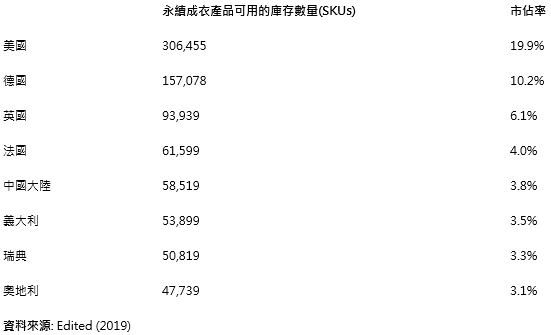
As shown in Table 1 According to the report, the United States, Germany, the United Kingdom, France, China and Italy are the world’s major sustainable clothing markets in terms of the number of stocks sold (SKUs). It is worth noting that with the exception of China, all major markets are developed countries, especially the United States and Western Europe – indicating a close relationship between consumer purchasing power and demand for sustainable clothing products.
In addition, the results show that retailers adopt a range of communication strategies for their sustainable clothing products. For example, some businesses emphasize the use of specialized environmentally friendly dyes or fabric ingredients (such as organic cotton or Tencel) for their products. Others emphasize that their sustainable products have been verified by reputable third-party organizations such as bluesign, Fairtrade, and B-Corp.
Table 2: Major sellers of sustainable clothing
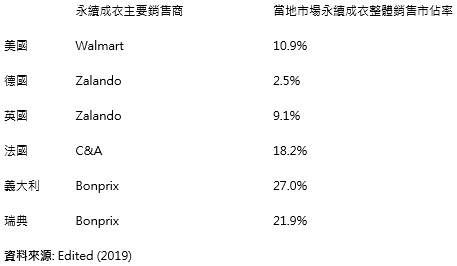
In addition, although everyone generally believes that the scale is larger of companies generally have more resources to promote sustainability, but the results show that small and medium-sized (SME) fashion retailers show greater enthusiasm for selling sustainable clothing. Interestingly, when we examined the majority of major sellers of sustainable clothing in most markets, they were mostly small and medium-sized retailers rather than well-known large retailers (Table 2). The only exceptions are the United States and France, where Walmart and C&A ranked first.
(2) Product portfolio strategy
Edited research results show that, Retailers are adopting unique product assortment strategies for sustainable and regular apparel products.
Table 3: Product mix by category – sustainable and regular garments (2016-2018)
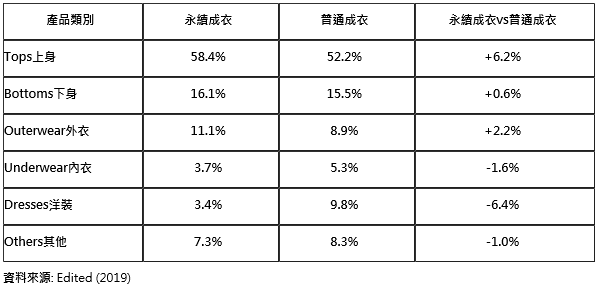
Firstly, compared to general ready-to-wear products, sustainable fashion is more concentrated in specific product categories globally, including upper body (58.4%), lower body (16.1%) and outerwear (11.1%). In contrast, there are fewer sustainable ready-to-wear products in the dress category (Table 3). There also appears to be a greater focus on sustainable ready-to-wear in country-specific product categories. For example, in the United States, sustainable tops (such as T-shirts, shirts, and sweatshirts) are particularly popular; in France, more brands of underwear are sustainable; and in Germany, there are more sustainability claims for outerwear than we examined. More than any other market.
Table 4: Sustainable apparel product portfolio by gender (2016-2018)

Second , in most markets around the world, retailers prioritize women’s clothing as sustainable ready-to-wear. As shown in Table 4, women’s clothing typically accounts for more than 60% of the total sustainable clothing available. This echoes previous research, which shows that women generally buy more clothes than men and are more focused on sustainability when shopping. The only exception is India. 67% of the sustainable clothing sold in the Indian retail market is concentrated in men’s clothing. This phenomenon may be related to India’s unique patriarchal socio-demographic and cultural factors.
Table 5: Color combinations of sustainable clothing and ordinary clothing (2016-2018)
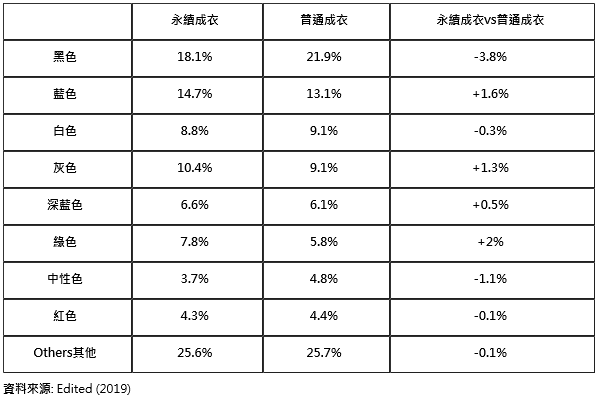
No. Three�� Regarding color combinations, sustainable garments tend to use more green and blue-toned dyes, and less black dyes, compared to regular garments (Table 5). Since green and blue are often psychologically associated with the earth and ocean, consumers may feel that garment products using these two colors are more “sustainable” than darker tones such as black. However, textile scientists say that in terms of manufacturing processes, there is no difference in the environmental impact of producing garments made with black, blue or green dyes. This highlights the fact that decisions to produce more sustainable green and blue products are based on psychological appeal to consumers rather than environmental impact considerations.
(3) Pricing strategy
Edited research results also show that, Fashion retailers are adopting different pricing strategies to differentiate sustainable clothing from regular clothing.
Table 6: Average retail prices of sustainable clothing and ordinary clothing
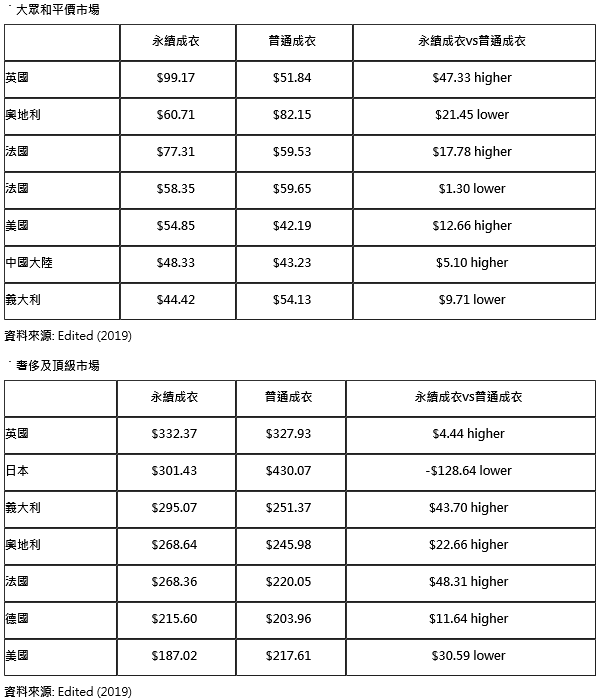
Most of the ones we studied In the country, the price of sustainable clothing is relatively higher than that of ordinary clothing, especially in the luxury and high-end markets (Table 6). This higher retail price is the result of a number of factors, including more expensive raw materials such as organic cotton, increased marketing expenditures such as advertising and promotions, and reduced consumer price sensitivity to sustainable clothing products. .
On the other hand, product mix can also explain different average prices. Sustainable ready-made clothing is mostly concentrated in products with lower added value, such as tops, while ordinary ready-made clothing focuses more on “expensive” and higher value-added products, such as dresses (Table 3) P-This means, Within product categories, the actual price differences between sustainable and conventional garments (e.g. T-shirts made from sustainable materials versus conventional T-shirts) may be even higher than the figures shown in Table 6.
Table 7: Percentage of products sold at discounts (2016-2018)
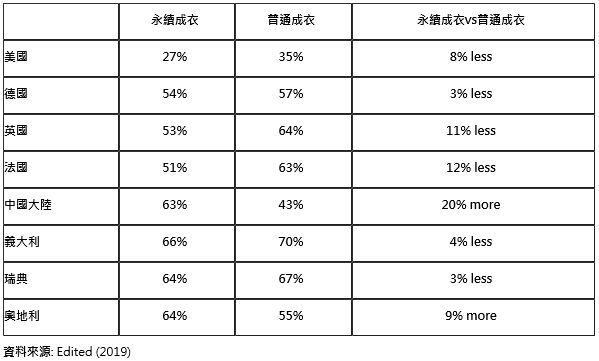
Table 8: Average price reduction percentage, sustainable clothing vs. ordinary clothing (2016-2018)
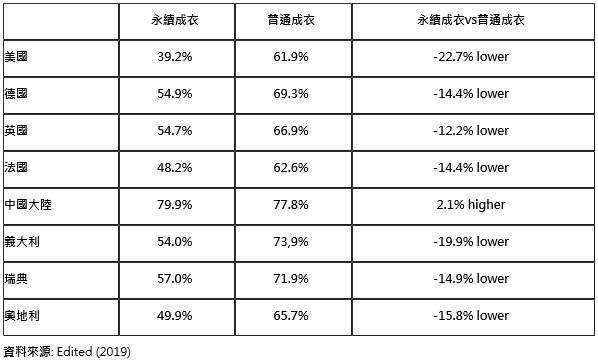
Fashion retailers in most markets around the world offer low promotional discounts for sustainable clothing For ordinary garments. As shown in Table 7, except for China and Austria, during the period 2016-2018, the number of sustainable clothing products sold at discounted prices in all markets we examined was approximately 3-12% lower than that of ordinary clothing products. Furthermore, as shown in Table 8, in most retail markets, the average price reduction of sustainable products is 12-22% lower than that of regular clothing.
This different discounting practice echoes previous findings that sustainable garments sell for higher prices overall and further confirms that consumers are willing to pay for sustainability Pay more for the product.
(IV) Conclusion
Our research analysis shows that fashion Retailers are adopting unique marketing strategies for the development of sustainable clothing, which are very different from the marketing practices of ordinary clothing products. As more and more companies turn to sustainable development, companies such as Levi Strauss & Co, Everlane and Patagonia reflect the success of these leaders in the sustainable development of products. It will be interesting to see how increased competition and related product offerings continue to change the growing consumer market for sustainable products, coupled with these exciting market dynamics.
AAAGFHTRYKUYIU7OUP






